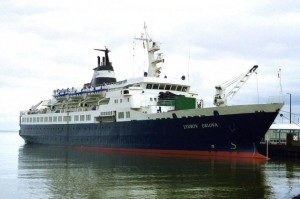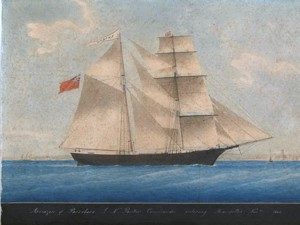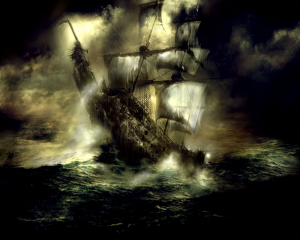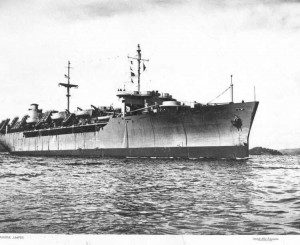
The MV Lyubov Orlova
Did you read, a couple weeks ago, about the MV Lyubov Orlova? You probably did, or at least you saw the headlines about it. You remember…the bio-hazardous ghost ship loaded with cannibalistic rats that’s headed, adrift, toward the UK?
Experts aren’t, or weren’t sure exactly where Lyubov Orlova is, in fact they aren’t even totally sure it’s still afloat. It left port at St. John’s Newfoundland in 2012 under tow, en-route to the Dominican Republic for scrap/salvage, after it was seized by a Canadian charter company in 2010 in consideration of debts owed by the ships Yugoslavian owners.
The 38 year old cruise vessel broke free of its tow during a storm and has been adrift somewhere in the North Atlantic Ocean ever since. The call to alarm by British mariners isn’t really based on solid information though, since most believe the ship sank long ago. Some of its lifeboat emergency beacons have activated, indicating that they came into contact with water (as they’re designed to do), which would suggest that it did indeed capsize, but some are yet to be activated, which gives some people cause to believe it may still be headed to the Devon coast of Britain.

An 1861 painting of The Amazon, which was later renamed The Mary Celeste
Disease ridden and filled with cannibal rats, the MV Lyubov Orlova is a decent representative of the long maritime tradition of ghost ship stories. You may be familiar with some of the more famous names in this tradition, such as the Flying Dutchman of ancient maritime folk lore – which was adapted by the Pirates of the Caribbean movie franchise and attributed to the fictional Captain Davey Jones – and perhaps the Mary Celeste, a merchant brigantine found abandoned and adrift in the Atlantic Ocean in December of 1872. The experienced crew of the Mary Celeste was never found, and there was no apparent reason for them to have abandoned what was still a seaworthy vessel, with six months’ worth of food and supplies still on board.
Among that fine seafarer’s tradition there are some names that, though they may be little known, deserve to have their story told.
The S.S. Ourang Medan, a Dutch cargo vessel used to run goods in and around the Indonesian islands, is one of those stories. The Ourang Medan, which apparently means ‘Man of Medan’ in the Malay language, whereas Medan is the name of the largest city on the Indonesian island of Sumatra, is the subject of one of the weirdest ghost ship stories going.

An artists depiction of the mythical Flying Dutchman
In February 1948, it was reported that several ships in the area of the South Atlantic received a radio distress call from an unidentified radio operator apparently aboard the Ourang Medan. The mayday included a simple Morse code message which read:
“All officers including captain are dead lying in chartroom and bridge. Possibly whole crew dead. I die.”
Having had their day ruined by receipt of that creepy message, a number of ships began searching for vessels in distress, including the American vessels the City of Baltimore and the Silver Star. It was the crew of the Silver Star who eventually found the Ourang Medan adrift near the Strait of Malacca. Upon boarding her in a valiant rescue attempt, the Silver Star crew were horrified to find corpses littering the ship, most in terrifying death poses, including one dog with a snarl forever frozen on its face.
 Soon after boarding, however, a mysterious fire broke out and forced the investigating crew off of the boat. Once safely back aboard their own ship, the crew then watched as the Ourang Medan burst into flames, exploded and eventually sank to the bottom of the South Atlantic Ocean.
Soon after boarding, however, a mysterious fire broke out and forced the investigating crew off of the boat. Once safely back aboard their own ship, the crew then watched as the Ourang Medan burst into flames, exploded and eventually sank to the bottom of the South Atlantic Ocean.
No one knows what happened. No one knows what they were carrying, or if they encountered marauders or mutiny, but it seems clear that something strange happened on the decks of that ship.
Several theories have been put forward. Among them are warnings about transporting dangerous goods and the dangers of cabin fever at sea. Some people suggest that a situation such as that depicted in Stanley Kubrick’s The Shining may have led to the crew’s demise.
The leading theories at this time are that the Ourang Medan was carrying, or perhaps smuggling, war-time supplies such as nerve gas agents or possibly a combination of potassium cyanide and nitroglycerine. It’s thought that seawater could have leaked into the cargo hold and interacted with these chemicals, releasing poison gas and eventually causing an explosion.
Others suggest that the old ship could have experienced engine trouble, which released carbon monoxide, causing the crew to asphyxiate and ultimately leading to an engine fire.
These kinds of common sense, real-world explanations may work to explain the situation, but Fortean investigators have some more interesting theories, as you might imagine.
Morris K. Jessup wrote in his book The Case for the UFO (Citadel 1955), that the crew of the Ourang Medan were attacked by alien forces. He highlighted the reports of the deceased crew apparently pointing to an unknown entity in their death poses, as evidence that some kind of real force or entity was involved in their deaths.
Others have claimed that demons or ghosts might have been involved, but it seems strange that few people have considered that real life pirates may have been responsible.
Whichever explanation you favour, it’s important to note that there are some who claim the whole thing is nothing more than myth. Several researchers and skeptics have delved into this story only to come away scratching their heads. It turns out that there is no record of the S.S. Ourang Medan operating in the Indonesian islands, nor is there a record of the incident in journals or registers of the time. This might not be surprising if she was indeed a smuggler’s vessel and considering the year, but there should be some record. Lloyd’s Register (or Lloyd’s Shipping Register) has no mention of such a ship being built, anywhere (though it could have been built under a different name and then rededicated later).
The American ship Silver Star does exist, but there is apparently no record that she ever participated in a rescue operation like that described above. On top of it all, the wreck of the Ourang Medan has never been located, which in and of itself is not a deal closer, since it’s a big ocean and the exact location of the incident is not known, but it adds to the reasonable doubt.
However you want to cut it, the tradition of ghost ships has a history of exaggerating or fabricating wild tales that mystify and amuse those of us who identify with such things. The ocean is a mysterious character in the human story, we know so little about it, and those who spend their lives exploring it and working on it embody that mystery. There’s no shortage of weird tales of sea monsters, perfect storms, fish that got away, and of course the ever shadowy ghost ship.
They are the storytellers, and we wait to be entertained…
